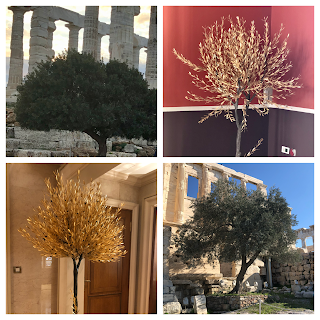My recent trip to Athens Greece was quite remarkable in many ways. We went there just before the Covid 19 struck the entire world. Since then any travels seem like a distant dream and I am so grateful to have visited the place , a choicest destination for any Art lover!
It was also the first time I saw the ancient city of Athens not through the big pages of Janson’s Art History book or a picture posted online but with my own organic eyes!
Decades ago as an Art History major I would often look at the pictures of Nike or the grand fluted pillars of Acropolis and wondered if I would ever see them. I finally saw and experienced the majestic art and architecture of Greece. Here are a few things that caught my attention in a mild or impactful manner.
Goddess Athena : The main Goddess of Athens, goddess of wisdom and war,
and patron of arts and crafts. She was the one who gifted the Olive Trees to Athens. Interesting fact : Did you know that there is a full replica of the statue of Athena in The Parthenon in Centennial Park, here in the USA ,in Nashville, Tennessee built in 1897.
Column Orders and a Special plant: Classical Columns ( or Pillars in layman’s words) in architecture that we see all over the world, from the White House to the porches of our homes were also a gift from the ancient Greeks! I still remember studying these column orders in great detail during my BFA days! But keeping it simple ~ there are three styles of columns 1.Doric order - simplest and the smallest.
2. Ionic order- taller and had a scroll like vault on the top. 3.Corinthian order- the most decorative , tallest(and my favorite).
While taking a tour of the Temple of Zeus (which still has 15 Corinthian columns standing ), the guide showed a plant nearby, to which I didn’t pay much attention, until I came to know that this plant was perhaps the inspiration for the elaborate design of the Corinthian columns! It's called the Acanthus plant and grows wild in the area. Clearly so, I could then make a direct connection between the shape of the leaves and designs donning the capital of the grand pillars!
One of the most prized sculptures of the Hellinestic Period is the Nike of Samothrace the winged goddess of Victory. There is a small Temple dedicated to Athena Nike at Parthenon. However the Nike of Samothrace which I had been wanting to see up close is not in Athens but at the Louvre Paris! It is undoubtedly the star attraction of the Louvre Museum (apart from Monalisa ). Made around 2000 years ago,it is awe inspiring to think the way white marble had been carved with many tactile textures, the contrapposto pose capturing the moment Nike just landed on the ground, the way the sculpture emits and weaves the energy around is absolutely remarkable! One needs to see this to experience it.
But until our future impending trip to the Louvre, we decided to get this gorgeous marble replica of the Nike of Samothrace from Athens, and now descends and graces my home!
Arch of Hadrian: Just 2 minutes away from the Temple of Zeus is the Arch of Hadiran. Back in 2c AD it divided the old and new cities. Now it’s right in the middle of the city, just off the main road. The archway is made out of marble, standing tall and wide with Corinthian columns on the top story, it also has some inscriptions on it.
After looking at the monument ,that particular day, as we walked around the cobblestone streets in the Plaka area (market), I gave more attention to the quaint windows, arches and decorative doorways of the regular greek households. They had a character of their own, a charming reminder that aesthetics and colors bring joy to everyone, no matter where you are , who you are, powerful or ordinary , mighty or mundane.
The Olive Trees! Who doesn’t like EVOO !(Extra Virgin Olive Oil)
Known for its profound qualities, this plant is the top choice for salad lovers like me, especially the Kalamata olives !
Legend has it that the olive tree was gifted to the city of Athens by Athena in a contest against Poseidon, which she won, as the people chose her gift (olive tree) rather than Poseidon’s (salty spring water) !
I saw these trees represented in many ways : metal sculpture, decorative artifacts & wreaths, patterns on textile and of course olive plantation all over in the region. It is said that an olive tree (highlighted in pic’s) is planted in the very same location as the first olive tree given to the city of Athens ! No it's not that old though ! The present tree is around 60 years old~ It stands in front of the Temple of Erechtheion on the Acropolis.
City views : Athens is beautifully set in between many small hills, surrounding it like a garland. It also offers many high hill top locations to see some stunning panoramic views, espeically at night.
The Parthenon being the center point of the city, looks spectacular both during the day and night. The highest point in the city is Lykavittos, (seen in pictures taken from the Acropolis). Some panoramic views taken from Delphi were also mesmerizing. The greenery was fresh and vibrant in contrast to the hills and rocks, standing still for thousands of years.
This culmination of the new and the ancient was a calming and humbling experience. I tried to absorb these moments by consciously paying attention to deep breathing and being present in the ‘now’. Those moments are now stored in my eternal gratitude file to be cherished forever !








